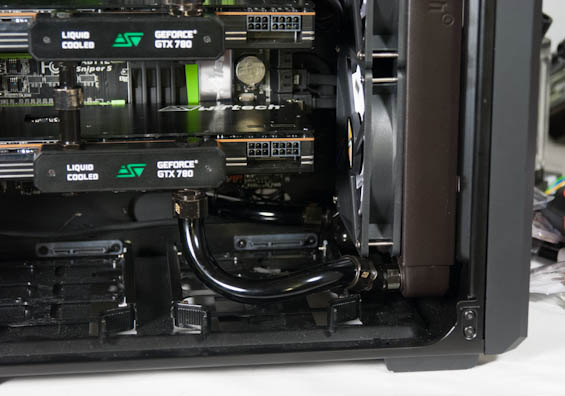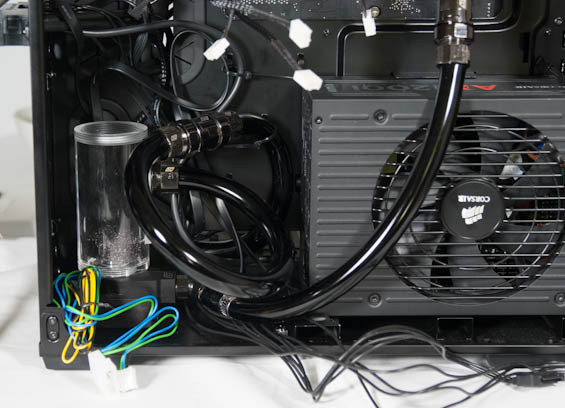The Neophyte's Custom Liquid Cooling Guide: How To, Why To, What To Expect
by Dustin Sklavos on September 30, 2013 12:01 AM ESTFor my build, I ran into a series of small but notable issues that made me question whether I'd made the right decision in opting to use the Corsair Carbide Air 540, specifically in terms of clearance. I opted to use the two in-line quick-release connects on the radiators; I'd connect an arbitrary amount of tubing to one of the ports on the radiator and then put half of one of the connects on the other end of the tube before routing that tube back behind the motherboard tray. This made assembly much easier as I didn't have to install the pump and reservoir early on or measure out the length of tubing I'd need; I'd just affix the appropriate amount of tubing along with the other half of the quick-release to the reservoir and pump.

My first major problem child was the 360mm radiator in the front. Originally I'd wanted the fans on the outside in a push configuration instead of pull, but you can see clearance around one of the two 3.5" drive trays wound up being extremely cramped. There's stress being put on that joint (as well as a bit on the connector that's routed back behind the motherboard tray), and I was concerned it would be likely to leak when I primed the system.
The other issue was routing the lines from the pump and reservoir. Because the power supply is so deep, and because power cabling naturally wanted to be in the same cubby area, real estate was at quite a premium. Before installing the pump I had to disconnect all of the modular power cables from the power supply just to get some breathing room.

You can see I also wound up using especially long lines from the pump in order to prevent any serious kinking, and this is all before the power cables wound up getting threaded back in.










106 Comments
View All Comments
bojaka - Monday, September 30, 2013 - link
And right about THERE I lost my interest in water cooling - Thanks :) I actually believed water cooling would be a viable solution to make my computer silent, but apparently not. Thanks for a great article!!utnorris - Monday, September 30, 2013 - link
You can make a near dead silent water cooled system that allows you to overclock. Unfortunately, the fans you are using in the article, while good, are not the best, regardless what marketing says. I have built probably 40 to 50 systems over the last 5 years using water cooling and noise was never an issue. If you are not overclocking then a full blown water cooling setup is not worth it, but for the added performance, it's well worth it. Also, there is no need for additives like the Hydrx, distilled water with a silver coil or some anti algae drops from your local pet store is all you need and would be less toxic. Last, as already mentioned, delidding would have seen about 10c drop on the processor and if you are going to water cool, you might as well delid your chip.Aikouka - Monday, September 30, 2013 - link
You REALLY shouldn't take a SINGLE article on water cooling as the end all, be all on whether water cooling can provide a silent build. Dustin was NOT pushing for a silent build, but rather just a build with whatever parts he was provided. I have a custom loop with an i7-4770k and two GTX 680s, and it isn't noisy at all. It is going to be a bit noisier at idle because of having significantly more fans (I have 7 120mm fans just on the radiators), but it doesn't get any noisier at load! I also use a fan controller that lets me set the fans to the speed -- and consequently, the noise level -- that I find acceptable.piroroadkill - Monday, September 30, 2013 - link
Yeah, some people think this, but since you're shifting water at the same time as pushing air, there are simply more moving parts involved. Just get a giant tower heatsink and run those fans sloooowly, and choose a GPU with a really good factory heatsink.tim851 - Monday, September 30, 2013 - link
Depends. There are much better, i.e. quieter, pumps available. The best one imo is the Aquastream by AquaComputer. Even then, a single Cpu-single Gpu system is quieter on air. A Thermalright HR-02 and an Accelero Xtreme will take care of it. Once you go SLI, however, you're running into space and heat evacuation problems. Watercooling is your only chance of acceptable noise at load now.piroroadkill - Monday, September 30, 2013 - link
Yeah, multi-GPU rigs are a different beast. At that point a custom water loop is probably your best bet.But for single CPU/single GPU rigs, water is basically a vanity project, not one that will actually give you lower noise.
piklar - Monday, September 30, 2013 - link
Great article Dustin! It just so happens I have been considering a watercooling project this summer (new Zealand time) using the Corsair Air540 with 4770K and SLI GTX 780s. Ironicly it appears The Raven RV03 is doing just as good if not better job of the cooling with Corsair H80 and reference card cooling. You have shown how luck of the draw Haswell can be since the 4770Ks Ive come across all do 4.6ghz on 2.8- 3.0v no probs. Still your article was very useful and much appreciated.Death666Angel - Monday, September 30, 2013 - link
2.8V to 3.0V? That's not right. :PRazorbak86 - Monday, September 30, 2013 - link
LOL. My thought exactly. I'm sure he meant 1.28-1.30V. ;-Ppiklar - Monday, September 30, 2013 - link
soz was half asleep, thanks for clarifying that I meant meant 1.280 - 1.30V for 4.6ghz with 4770K with H80.